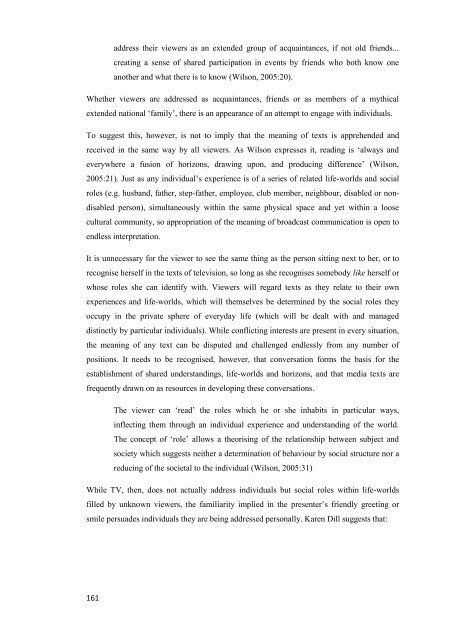A thesis submitted in partial fulfilment of - Etheses - Queen Margaret ...
A thesis submitted in partial fulfilment of - Etheses - Queen Margaret ...
A thesis submitted in partial fulfilment of - Etheses - Queen Margaret ...
You also want an ePaper? Increase the reach of your titles
YUMPU automatically turns print PDFs into web optimized ePapers that Google loves.
161<br />
address their viewers as an extended group <strong>of</strong> acqua<strong>in</strong>tances, if not old friends...<br />
creat<strong>in</strong>g a sense <strong>of</strong> shared participation <strong>in</strong> events by friends who both know one<br />
another and what there is to know (Wilson, 2005:20).<br />
Whether viewers are addressed as acqua<strong>in</strong>tances, friends or as members <strong>of</strong> a mythical<br />
extended national „family‟, there is an appearance <strong>of</strong> an attempt to engage with <strong>in</strong>dividuals.<br />
To suggest this, however, is not to imply that the mean<strong>in</strong>g <strong>of</strong> texts is apprehended and<br />
received <strong>in</strong> the same way by all viewers. As Wilson expresses it, read<strong>in</strong>g is „always and<br />
everywhere a fusion <strong>of</strong> horizons, draw<strong>in</strong>g upon, and produc<strong>in</strong>g difference‟ (Wilson,<br />
2005:21). Just as any <strong>in</strong>dividual‟s experience is <strong>of</strong> a series <strong>of</strong> related life-worlds and social<br />
roles (e.g. husband, father, step-father, employee, club member, neighbour, disabled or non-<br />
disabled person), simultaneously with<strong>in</strong> the same physical space and yet with<strong>in</strong> a loose<br />
cultural community, so appropriation <strong>of</strong> the mean<strong>in</strong>g <strong>of</strong> broadcast communication is open to<br />
endless <strong>in</strong>terpretation.<br />
It is unnecessary for the viewer to see the same th<strong>in</strong>g as the person sitt<strong>in</strong>g next to her, or to<br />
recognise herself <strong>in</strong> the texts <strong>of</strong> television, so long as she recognises somebody like herself or<br />
whose roles she can identify with. Viewers will regard texts as they relate to their own<br />
experiences and life-worlds, which will themselves be determ<strong>in</strong>ed by the social roles they<br />
occupy <strong>in</strong> the private sphere <strong>of</strong> everyday life (which will be dealt with and managed<br />
dist<strong>in</strong>ctly by particular <strong>in</strong>dividuals). While conflict<strong>in</strong>g <strong>in</strong>terests are present <strong>in</strong> every situation,<br />
the mean<strong>in</strong>g <strong>of</strong> any text can be disputed and challenged endlessly from any number <strong>of</strong><br />
positions. It needs to be recognised, however, that conversation forms the basis for the<br />
establishment <strong>of</strong> shared understand<strong>in</strong>gs, life-worlds and horizons, and that media texts are<br />
frequently drawn on as resources <strong>in</strong> develop<strong>in</strong>g these conversations.<br />
The viewer can „read‟ the roles which he or she <strong>in</strong>habits <strong>in</strong> particular ways,<br />
<strong>in</strong>flect<strong>in</strong>g them through an <strong>in</strong>dividual experience and understand<strong>in</strong>g <strong>of</strong> the world.<br />
The concept <strong>of</strong> „role‟ allows a theoris<strong>in</strong>g <strong>of</strong> the relationship between subject and<br />
society which suggests neither a determ<strong>in</strong>ation <strong>of</strong> behaviour by social structure nor a<br />
reduc<strong>in</strong>g <strong>of</strong> the societal to the <strong>in</strong>dividual (Wilson, 2005:31)<br />
While TV, then, does not actually address <strong>in</strong>dividuals but social roles with<strong>in</strong> life-worlds<br />
filled by unknown viewers, the familiarity implied <strong>in</strong> the presenter‟s friendly greet<strong>in</strong>g or<br />
smile persuades <strong>in</strong>dividuals they are be<strong>in</strong>g addressed personally. Karen Dill suggests that:




